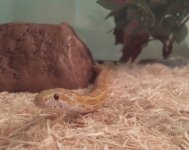Hi all! I'm new to this forum and it looks like there are people here who might be able to answer some of my morph questions. I spent the last couple of months looking at a ton of gorgeous snakes and finally got my first corn snake a few weeks ago. Some genes seem to have really obvious effects on the color or pattern and others are impossible for me to tell apart from just the photo (via iansvivarium). I managed to find some articles describing a few common genes and the unexpected traits that come with them (e.g. stripe affecting belly checkers), but nothing nearly as complete as I was hoping for. Is there a good resource out there you can recommend that has something like a table of genes and written descriptions of corresponding traits?
Also, how common are these morphs in the wild? If I ever stumbled across a corn snake in my yard, could I know if it's more than likely someone's lost pet?
Bonus pic of my lovely amber girl:
Welcome to the forum...
Ian's Viv
used to have description with, not all, but most traits listed on their site. A large update last year or in 2014 seems to have caused that knowledge to have disappeared.
Don Soderberg's (South Mountain Reptiles) website can be excellent for knowledge of traits, as can VMS Herp's page. From there, your best sources are going to be Don's book on corn snakes and the AVS series book by Bill & Kathy Love pertaining to corn snakes. Mine are still packed from moving, otherwise I'd toss up the titles. Simple googling should yield them for you.
There is also a digital book on corn mutations, the Cornsnake Morph Guide by Charles Pritzel. I think it's like $10.
Some of these morphs originated in the wild. The first albino was road cruised in the 1950s in North Carolina. Anery Type A and B, as well as I believe Caramel are mutation originating from south Florida. Anery Type A can, at times, be easily found in the wild.
That in mind, if you stumbled upon a corn snake in Wisconsin then it's 99.999999999999% guaranteed to be an escapee. Up there you'll have black or western rat snakes, depending on how you want to view the taxonomy, and fox snakes (either eastern or western, I'm not sure which). Corn snakes and Great Plains rat snake (formerly a subspecies of corn snake) don't naturally range that far north. GP rats get into west-central IL and extreme SW Iowa, and with relation to you, the closest corn snakes get are a few pockets in Kentucky.

